
views
X
Research source
As long as you know the side length of the hexagon, you can calculate the length of the apothem.
Using the Pythagorean Theorem (Given Side Length or Radius)

Divide the hexagon into six congruent, equilateral triangles. To do this, draw a line connecting each vertex, or point, with the vertex opposite.

Choose one triangle and label the length of its base. This is equal to the side length of the hexagon. For example, you might have a hexagon with a side length of 8 cm. The base of each equilateral triangle, then, is also 8 cm.
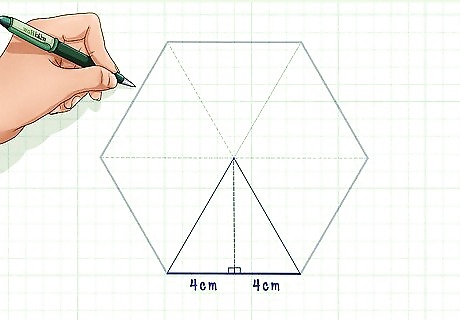
Create two right triangles. To do this, draw a line from the top vertex of the equilateral triangle perpendicular to its base. This line will cut the base of the triangle in half (and thus is the apothem of the hexagon). Label the length of the base of one of the right triangles. For example, if the base of the equilateral triangle is 8 cm, when you divide the triangle into two right triangles, each right triangle now has a base of 4 cm.
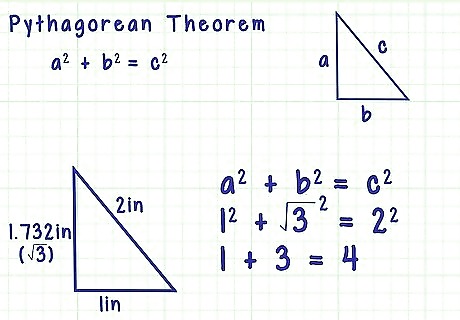
Set up the formula for the Pythagorean Theorem. The formula is a 2 + b 2 = c 2 {\displaystyle a^{2}+b^{2}=c^{2}} a^{{2}}+b^{{2}}=c^{{2}}, where c {\displaystyle c} c equals the length of the hypotenuse (the side opposite the right angle), and a {\displaystyle a} a and b {\displaystyle b} b equal the lengths of the other two sides of the triangle. For example, if a right triangle had a hypotenuse of 2 {\displaystyle 2} 2 inches, one leg of 1 {\displaystyle 1} 1 inch, and another leg of about 1.732 {\displaystyle 1.732} 1.732 inches ( 3 {\displaystyle {\sqrt {3}}} {\sqrt {3}}), the Pythagorean Theorem would state that 1 2 + 3 2 = 2 2 {\displaystyle 1^{2}+{\sqrt {3}}^{2}=2^{2}} 1^{{2}}+{\sqrt {3}}^{{2}}=2^{{2}}, which is true when you complete the calculations: 1 + 3 = 4 {\displaystyle 1+3=4} 1+3=4.
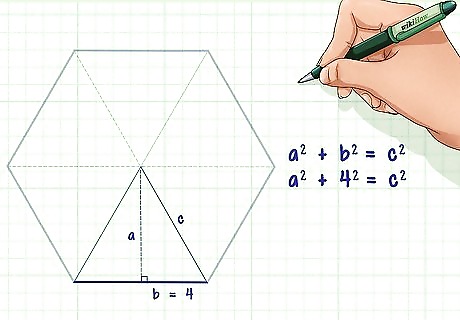
Plug the length of the right triangle’s base into the formula. Substitute for b {\displaystyle b} b. For example, if the length of the base is 4 cm, your formula will look like this: a 2 + 4 2 = c 2 {\displaystyle a^{2}+4^{2}=c^{2}} a^{{2}}+4^{{2}}=c^{{2}}.
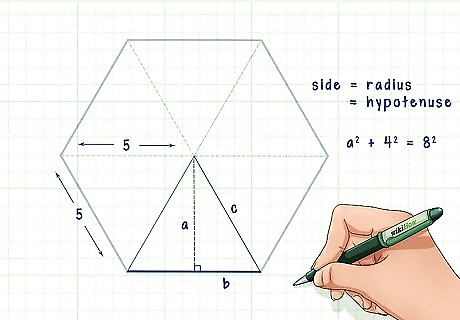
Plug the length of the hypotenuse into the formula. You know the length of the hypotenuse because you know the side length of the hexagon. The side length of a regular hexagon is equal to the radius of the hexagon. The radius is a line that connects the central point of a polygon with one of its vertices. You’ll note that the hypotenuse of your right triangle is also a radius of the hexagon, thus, the side length of the hexagon is equal to the length of the hypotenuse. For example, if the side length of the hexagon is 8 cm, then the length of the right triangle’s hypotenuse is also 8 cm. So your formula will look like this: a 2 + 4 2 = 8 2 {\displaystyle a^{2}+4^{2}=8^{2}} a^{{2}}+4^{{2}}=8^{{2}}.
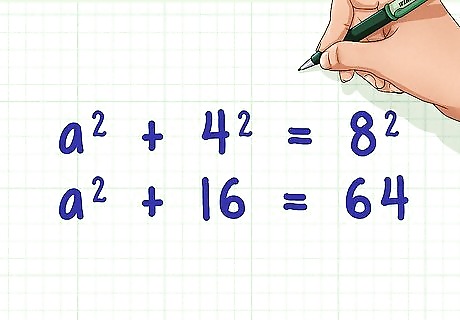
Square the known values in the formula. Remember that squaring a number means to multiply it by itself. For example, squaring the known values, your formula will look like this: a 2 + 16 = 64 {\displaystyle a^{2}+16=64} a^{{2}}+16=64.
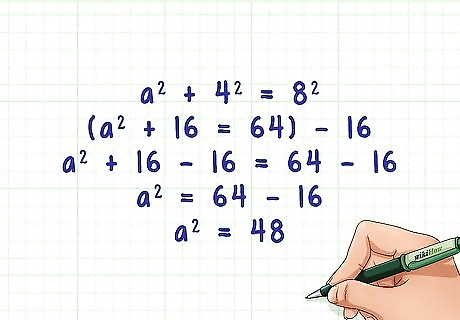
Isolate the unknown variable. To do this, subtract the squared value of b {\displaystyle b} b from both sides of the equation. For example: a 2 + 16 − 16 = 64 − 16 {\displaystyle a^{2}+16-16=64-16} a^{{2}}+16-16=64-16 a 2 = 48 {\displaystyle a^{2}=48} a^{{2}}=48
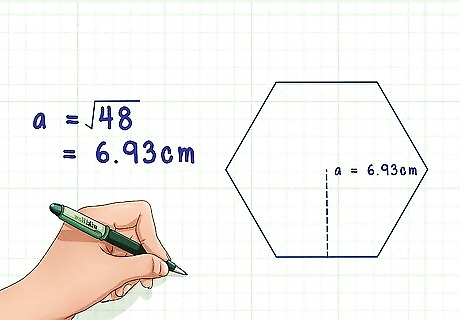
Solve for a {\displaystyle a} a. To do this, find the square root of each side of the equation. This will give you the length of the missing side of the triangle, which is equal to the length of the hexagon’s apothem. For example, using a calculator, you can calculate 48 = 6.93 {\displaystyle {\sqrt {48}}=6.93} {\sqrt {48}}=6.93. Thus, the missing length of the right triangle, and the length of the hexagon’s apothem, equals 6.93 cm.
Using Trigonometry (Given Side Length or Radius)
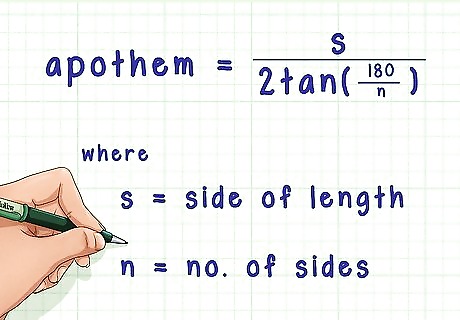
Set up the formula for finding the apothem of a regular polygon. The formula is apothem = s 2 tan ( 180 n ) {\displaystyle {\text{apothem}}={\frac {s}{2\tan({\frac {180}{n}})}}} {\text{apothem}}={\frac {s}{2\tan({\frac {180}{n}})}}, where s {\displaystyle s} s equals the side length of the polygon and n {\displaystyle n} n equals the number of sides the polygon has.
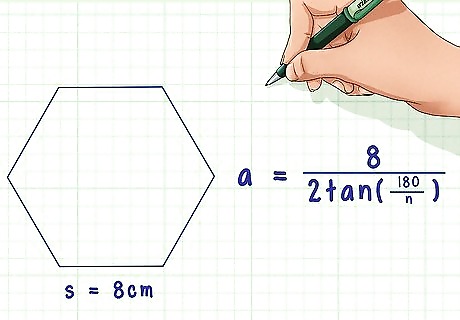
Plug the side length into the formula. Remember to substitute for the variable s {\displaystyle s} s. For example, for a hexagon with a side length of 8 cm, the formula will look like this: 8 2 tan ( 180 n ) {\displaystyle {\frac {8}{2\tan({\frac {180}{n}})}}} {\frac {8}{2\tan({\frac {180}{n}})}}.
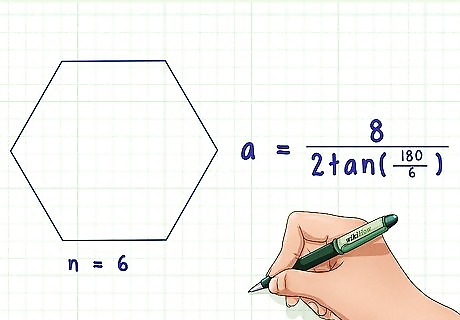
Plug the number of sides into the formula. A hexagon has 6 sides. Remember to substitute for the variable n {\displaystyle n} n. For example: 8 2 tan ( 180 6 ) {\displaystyle {\frac {8}{2\tan({\frac {180}{6}})}}} {\frac {8}{2\tan({\frac {180}{6}})}}.

Complete the calculation in parentheses. You are finding the degrees you will use to calculate the tangent. For example, 180 6 = 30 {\displaystyle {\frac {180}{6}}=30} {\frac {180}{6}}=30, so the formula now look like this: 8 2 tan ( 30 ) {\displaystyle {\frac {8}{2\tan(30)}}} {\frac {8}{2\tan(30)}}.
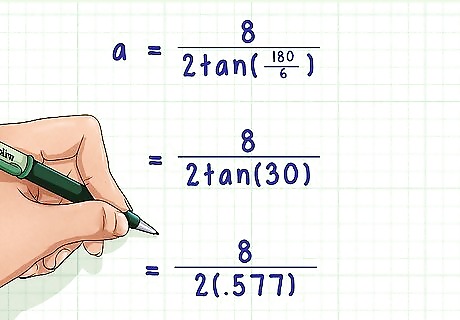
Find the tangent. To do this, use a calculator or a trigonometry table. For example, the tangent of 30 is about .577, so the formula will now look like this: 8 2 ( .577 ) {\displaystyle {\frac {8}{2(.577)}}} {\frac {8}{2(.577)}}.

Multiply the tangent by 2, then divide the side length by this number. This will give you the length of the apothem of your hexagon. For example: apothem = 8 2 ( .577 ) {\displaystyle {\text{apothem}}={\frac {8}{2(.577)}}} {\text{apothem}}={\frac {8}{2(.577)}} apothem = 8 1.154 {\displaystyle {\text{apothem}}={\frac {8}{1.154}}} {\text{apothem}}={\frac {8}{1.154}} apothem = 6.93 {\displaystyle {\text{apothem}}=6.93} {\text{apothem}}=6.93So, the apothem of a regular hexagon with 8-cm sides is about 6.93 cm.




















Comments
0 comment